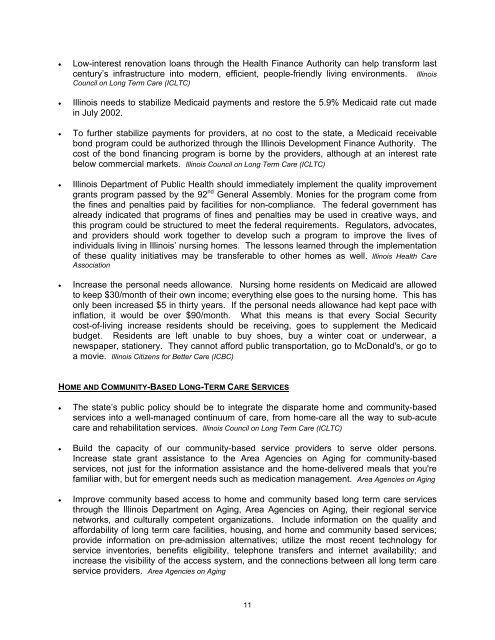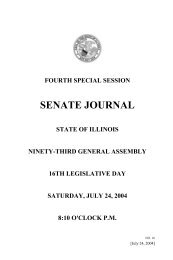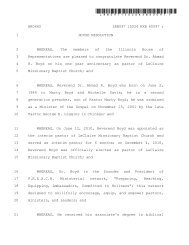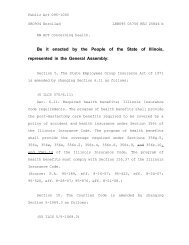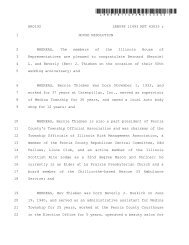Long-Term Care - Illinois General Assembly
Long-Term Care - Illinois General Assembly
Long-Term Care - Illinois General Assembly
You also want an ePaper? Increase the reach of your titles
YUMPU automatically turns print PDFs into web optimized ePapers that Google loves.
• Low-interest renovation loans through the Health Finance Authority can help transform last<br />
century’s infrastructure into modern, efficient, people-friendly living environments. <strong>Illinois</strong><br />
Council on <strong>Long</strong> <strong>Term</strong> <strong>Care</strong> (ICLTC)<br />
• <strong>Illinois</strong> needs to stabilize Medicaid payments and restore the 5.9% Medicaid rate cut made<br />
in July 2002.<br />
• To further stabilize payments for providers, at no cost to the state, a Medicaid receivable<br />
bond program could be authorized through the <strong>Illinois</strong> Development Finance Authority. The<br />
cost of the bond financing program is borne by the providers, although at an interest rate<br />
below commercial markets. <strong>Illinois</strong> Council on <strong>Long</strong> <strong>Term</strong> <strong>Care</strong> (ICLTC)<br />
• <strong>Illinois</strong> Department of Public Health should immediately implement the quality improvement<br />
grants program passed by the 92 nd <strong>General</strong> <strong>Assembly</strong>. Monies for the program come from<br />
the fines and penalties paid by facilities for non-compliance. The federal government has<br />
already indicated that programs of fines and penalties may be used in creative ways, and<br />
this program could be structured to meet the federal requirements. Regulators, advocates,<br />
and providers should work together to develop such a program to improve the lives of<br />
individuals living in <strong>Illinois</strong>’ nursing homes. The lessons learned through the implementation<br />
of these quality initiatives may be transferable to other homes as well. <strong>Illinois</strong> Health <strong>Care</strong><br />
Association<br />
• Increase the personal needs allowance. Nursing home residents on Medicaid are allowed<br />
to keep $30/month of their own income; everything else goes to the nursing home. This has<br />
only been increased $5 in thirty years. If the personal needs allowance had kept pace with<br />
inflation, it would be over $90/month. What this means is that every Social Security<br />
cost-of-living increase residents should be receiving, goes to supplement the Medicaid<br />
budget. Residents are left unable to buy shoes, buy a winter coat or underwear, a<br />
newspaper, stationery. They cannot afford public transportation, go to McDonald's, or go to<br />
a movie. <strong>Illinois</strong> Citizens for Better <strong>Care</strong> (ICBC)<br />
HOME AND COMMUNITY-BASED LONG-TERM CARE SERVICES<br />
• The state’s public policy should be to integrate the disparate home and community-based<br />
services into a well-managed continuum of care, from home-care all the way to sub-acute<br />
care and rehabilitation services. <strong>Illinois</strong> Council on <strong>Long</strong> <strong>Term</strong> <strong>Care</strong> (ICLTC)<br />
• Build the capacity of our community-based service providers to serve older persons.<br />
Increase state grant assistance to the Area Agencies on Aging for community-based<br />
services, not just for the information assistance and the home-delivered meals that you're<br />
familiar with, but for emergent needs such as medication management. Area Agencies on Aging<br />
• Improve community based access to home and community based long term care services<br />
through the <strong>Illinois</strong> Department on Aging, Area Agencies on Aging, their regional service<br />
networks, and culturally competent organizations. Include information on the quality and<br />
affordability of long term care facilities, housing, and home and community based services;<br />
provide information on pre-admission alternatives; utilize the most recent technology for<br />
service inventories, benefits eligibility, telephone transfers and internet availability; and<br />
increase the visibility of the access system, and the connections between all long term care<br />
service providers. Area Agencies on Aging<br />
11


